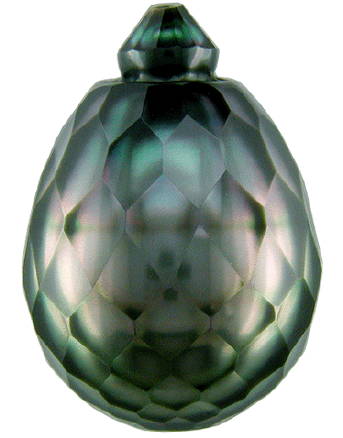There are two major types of cultured pearls; freshwater and saltwater pearls.
Freshwater pearls primarily come from China.
Saltwater pearls, which include Akoya, Tahitian, and South Sea, are grown in bays, inlets, and atolls in many places around the world.
South Sea pearls are some of the rarest and most valued pearls in the world.
They are distinguished predominantly by their large size and are generally the largest cultured pearls on the market.
The majority of South Sea cultured pearls are about 13.0 mm in diameter, whereas most Akoya cultured pearls are 6.0 mm to 7.0 mm.
South Sea pearls are cultured in the warm South Sea waters of Australia, Indonesia, the Philippines, Myanmar (formerly Burma), and Thailand, with sixty percent of South Sea pearls from Australia.
Due to the warm climate and longer harvest time, South Sea pearls have an exceptionally thick nacre ranging from 2.0 mm to 6.0 mm.
The thicker layers of nacre in South Sea pearls create more of a satiny luster than the mirror-like sharpness of an Akoya pearl.
They tend to glow from within rather than reflect.
South Sea pearls are not treated or bleached in any way post-harvest and are prized for their unusual natural body color.

South Sea pearls generally range from 10.0 mm to 15.0 mm but can reach upwards of 20mm.

South Sea pearls come in unique shades of colors ranging from a bright white to deep yellowish-orange.
Ninety percent of South Sea pearls produced are white, cream, or silver.
They can exhibit overtones of rose, green and blue.
The overtone on a South Sea pearl is usually less apparent than the body color.
South Sea Pearl’s most striking characteristics are their unusual color and larger size.
They are the most expensive pearls on the market.
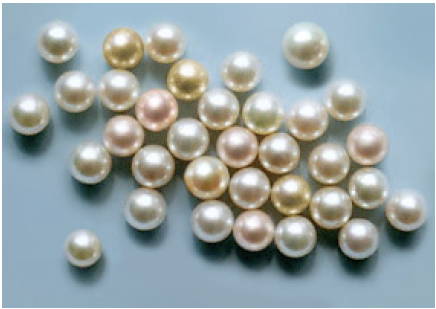
This system grades pearls on a scale from A to AAA.

Characteristic of the Akoya pearl
The Akoya oyster is the smallest of the pearl-producers.
Adults are only 3 to 5 inches in diameter.
Because the oyster is small, so is the pearl.
Typical Akoya pearls range from 2 mm to 11 mm, with the 10 and 11 mm sizes rare finds.
Akoyas frequently rank “excellent” in most pearl value factors.
That’s why many Akoya pearls are sold as strands.
The reason the pearls can be so easily matched is that most of them are round or near-round.
The Akoya pearl is either white or cream in body color with rose, cream, silver, or ivory overtones.
Some Akoya pearls achieve a black body color through a process called irradiation.
It typically has an excellent, good, or fair luster, which is why the Akoya is such a prized gem.
The best pearls have clean surface quality and acceptable nacre.
The most highly valued Akoyas are larger, have excellent luster, and clean surface quality.
Akoya pearls in jewelry
By far, most Akoyas are strung in the traditional pearl necklace.
These popular jewelry pieces become family heirlooms.
They are often a “Sweet 16” present or accessorize wedding gowns.
Pearl necklaces come in various sizes, but the 14- to 16-inch choker and the 17-to 19-inch princess are the two most popular.
Akoyas are also popular in strand bracelets, earrings, rings, pendants, brooches, tie tacks and cufflinks.
Akoya Pearl Overtones
The color of an Akoya pearl is a combination of body color and overtone.
Generally, the body color will be white, cream or black with the white body color being more prized.
Although the black body color is not found naturally, it can be created through a process called irradiation, where the nucleus of the pearl is bombarded with gamma rays to achieve a permanent coloration of the pearl.
Within the white and cream body colors, you will witness an overtone present, usually in rose (pink), cream, or silver.
Below is an example of the 3 most common overtones found in white Akoya pearls:
Rose, Cream and Silver
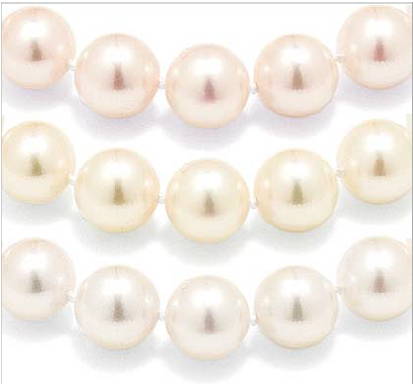
The primary grading system in fairly widespread use, and used by nearly every major pearl retailer in the United States is the AAA-A system.
The AAA – A System
This system grades pearls on a scale from AAA to A, with AAA – or commonly known as gem-quality – the highest grade:
• AAA: The highest-quality pearl, virtually flawless.
The surface will have a very high luster, and at least 95% of the surface will be free from any defect.
The pearl will be perfectly round and have a mirror-like luster and a total nacre thickness of at least .75mm.
• AA: The surface will have a very high luster, and at least 75% of the surface will be free from any defect.
The luster will be very high and have a total nacre thickness of at least .5mm.
• A: This is the lowest jewelry-grade pearl, with a lower luster and/or more than 25% of the surface showing defects.
In many cases, if the pearl is being mounted into a piece of jewelry, it can be mounted so that the defects are hidden — thus providing a lovely jewelry piece at a lesser price.
This quality has a chalky appearance and thin nacre, typically of .25mm or less.
This thin nacre is due to early harvesting of the pearl.
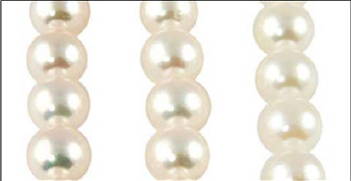
When it comes to quality pearls, like most gems, size does matter.
A critical factor in the value of a pearl is its size, with the larger pearls generally being the more prized.

• 5.5 mm-6 mm
These small pearls are traditionally worn by girls ages 12 to 16 or petite women.
• 6.0-6.5 mm
This size is the perfect gift for graduations or 16th birthdays.
They are usually worn by young women ages 16-24.
• 6.5 mm-7.0 mm
A strand of this size is considered the “starter” set for women in their mid-20s on up.
It is the traditional birthday, Christmas and Valentine’s Day present.
• 7.5 mm-8.0 mm
This size, traditionally worn by women age 30 and up, is the strand for the upwardly mobile woman.
Not too flashy, 8 mm is big enough to give an air of importance.
This size is a traditional wedding or anniversary gift through the fifth year of marriage.
• 8.0 mm-8.5 mm
These pearls tend to be more expensive, so they are traditionally worn by women age 35 and up, and often signify financial success.
• 8.5 mm-9.0 mm
A strand of this size is perfect for women ages 35 to 45 or a woman in her early 30s of high stature.
They exude class.
Jacqueline Kennedy’s famous pearls were this size.
• 9.0 mm-9.5 mm
These are very high-end pearls that are traditionally worn by women in their later years.
You’ll find these pearls in the jewelry boxes of wealthy women or dedicated pearl collectors.
• 9.5 mm-10.0 mm
Akoya pearls are rarely found in this size and even harder to match well, so they fetch a very high price on the jewelry market.
Former First Lady Barbara Bush owns pearls this size.
If you know much about pearls, you’ve heard of the fabled Mikimoto brand.
These cultured Akoya pearls are considered by many to be the best since the company (founded by Kokichi Mikimoto 100 years ago) has the most extensive experience in perfecting the culturing process.
The company has even its grading system for its production.

Unlike cultured saltwater pearls, freshwater pearls are not bead-nucleated and are therefore typically less round.
Instead of using a bead, a small square of mantle tissue is cut from a donor mussel’s inner lining and inserted into the lining of the harvesting mussel to instigate pearl formation.
The unique harvesting technique makes freshwater pearls purely composed of nacre.
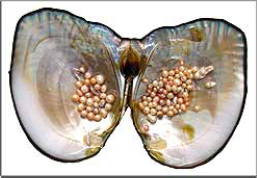
Only two percent of all freshwater pearls are round or near round.
Though this number seems quite small, the abundance of freshwater pearls is much higher than other pearl types.
Each freshwater mussel will produce up to 40 pearls, whereas one saltwater mollusk usually only produces one or two pearls.
The most common shape in freshwater pearls is oval or button-shaped (sixty percent).
Thirty-eight percent are Baroque and Semi-Baroque.
Almost all freshwater pearls come from China.
Since the 1990s, freshwater pearl quality has steadily increased.
Though you will never have a perfectly round freshwater pearl, the likelihood of finding a quality near round pearl is much higher today.

Freshwater pearls range from 2.0 mm to 15.0.
They have the widest size range of any pearl type.
6.0-7.0 mm pearls are best for petite persons or those wishing to maintain an understated, minimalist appeal.
Because the pearls are smaller, oftentimes, it is more likely to have rounder freshwater pearls.
7.0-8.0 mm pearls are slightly more substantial, while still making a refined statement.
9.0-10.0 mm pearls are well suited for young adults or mature teens.
10.0+mm freshwater pearls are often not as consistent in shape and size due to the rarity of their occurrence.
Furthermore, it is even less likely that a larger freshwater pearl will be round.
For these reasons, this size range tends to highlight the natural cultivation process of freshwater pearls.

Freshwater pearls produce the most extensive array of colors and shapes.
There are dozens of naturally occurring colors found in freshwater pearls.
Their body color can be white, cream, or colored (yellow, orange, pink, and purple).
Above are the 4 most common colors seen on the retail market today but by no means illustrate the full spectrum of possible colors.
Freshwater pearls are rich in “orient”, an optical effect where rainbows of colors shimmer beneath the pearl’s surface.
This effect is similar to shifting rainbows reflecting on soap bubbles.
Orient is commonly found in freshwater pearls due to their composition of pure nacre.
When freshwater pearls are dyed black, they enhance the orient and result in dark pools of color, similar to gasoline on pavement.
Freshwater pearls have overtones, but they are different from bead-nucleated pearls.
Typically freshwater pearls of lower quality show little to no overtone, though higher quality freshwater pearls can show overtones of rose, blue and green.
This system grades pearls on a scale from AAA to A, with a new grade being given to scarce and high-quality pearls.
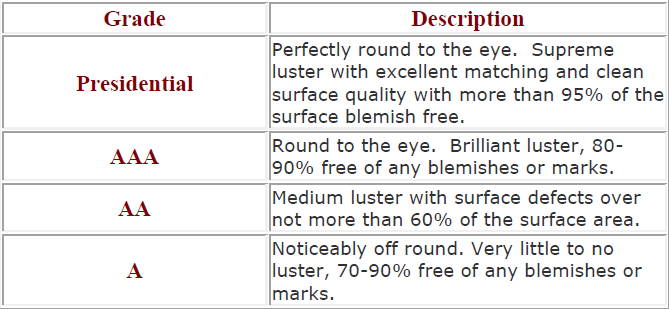
In just the 30 years they’ve been in the jewelry marketplace, the Tahitian cultured pearl has made its mark.
These big, colorful gems are prized for their large size and exotic naturally dark colors.
Not Only Black Pearls

You’ll often hear these gems referred to as “Tahitian Black Pearls.”
The name has caused a couple of misconceptions about the pearls.
First, Tahitian cultured pearls aren’t only black.
They appear in shades of brown, gray, blue, green, and purple as well.
They also have gorgeous overtones that give Tahitian cultured pearls an incredible beauty.
Secondly, the gems aren’t found in Tahiti.
Tahiti is the largest island in French Polynesia, but the pearl culturing farms are found on other islands in the territory, which is located in the South Pacific.
The pearls are found in a bivalve mollusk called the black-lipped oyster that is native to French Polynesia.
In nature, the black-lipped oyster can live up to 30 years, grows up to a foot in diameter, and weighs up to 1 pound.
During the years, it produces pearls, ages 3 to 7, the black-lipped oyster is usually between 6 and 8 inches in diameter.
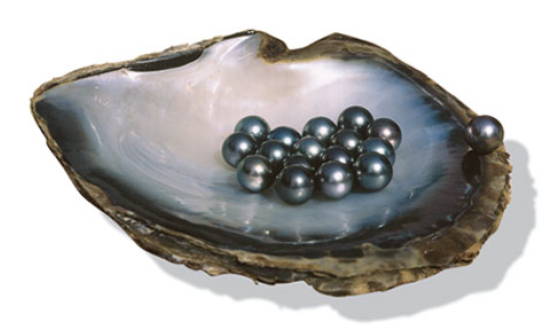
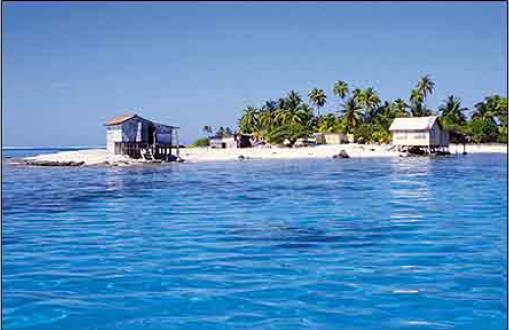
Tahitian cultured pearls are often high value on the pearl market.
They’re bigger than most pearls, are comprised of unusual colors, and take more time to produce.
Value is also tied to their demand – there are fewer Tahitian pearls produced than Akoyas.
An unusually large, extremely high-quality Tahitian cultured pearl can cost thousands of dollars.
A bargain when you consider that a graduated strand of 10 mm to 14 mm Tahitian pearls can fetch $30.000 to $40,000 from a retail jeweler!
One triple-strand jewelry piece ranging from 12 mm to 15 mm, was sold in the late 1980s for $880,000!
Size and Shape
One of the strongest value factors of Tahitian cultured pearls, is their size.
Most range between 8 mm and 14 mm.
Rarely pearls grow into the 16 mm to 18 mm range.
In the late 1990s, one specimen was recorded just shy of 27 mm.
Less than 50 percent of any Tahitian cultured pearl crop is round, so spherical gems have a much higher value.
Tahitian cultured pearls also are more likely to have circles -grooves or rings around them.
Although circled pearls have less value, some designers and jewelry lovers value them for their uniqueness.
Tahitian pearls have a high luster.
So great is the luster in most of the pearls that all they take is a little buffing once they are taken from the oyster.
Luster ranges from fair to excellent.
Often the luster produces a metallic sheen and an overtone.

Surface Quality
Most Tahitian cultured pearls have a few blemishes.
However, they can range from spotless to heavily spotted.
Most are heavily blemished in one area, which is hidden by the setting or a drill hole.
Most Tahitian cultured pearls have acceptable nacre.
Rarely do you find these pearls with visible nucleus or a chalky appearance.
In the years the pearl is allowed to cultivate, Tahitian cultured pearls often grow 2 mm of nacre around the nucleus.
It is also possible, when the nacre’s thickness is sufficient, to facet pearls.
It isn’t that common, but it for sure looks very special!

